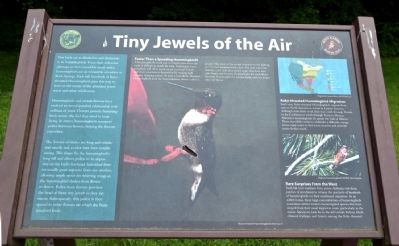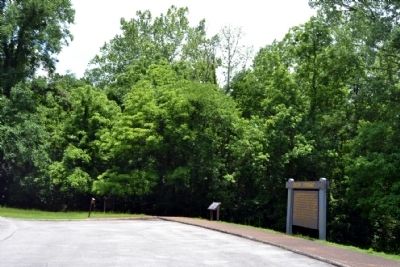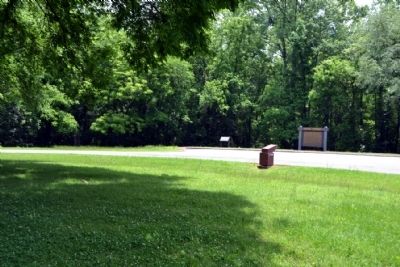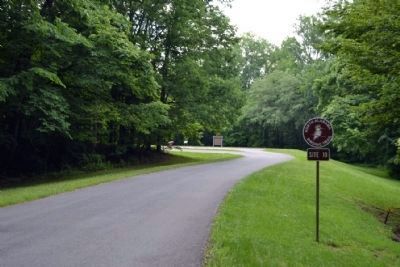Near Waterloo in Lauderdale County, Alabama — The American South (East South Central)
Tiny Jewels of the Air
Hummingbirds and certain flowers have evolved an interdependent relationship over millions of years. Flowers provide humming-birds nectar, the fuel they need to keep flying. In return, hummingbirds transport pollen between flowers, helping the flowers reproduce.
The flowers of choice are long and tubular and usually red, a color bees have trouble seeing. This shape fits the hummingbird’s long bill and allows pollen to be deposited on the bird’s forehead. Individual flowers usually grow separate from one another, allowing ample space for whirring wings as the hummingbird dashes from flower to flower. Pollen from flowers powders the head of these tiny jewels as they sip nectar. Subsequently, this pollen is then spread to other flowers on which the hummingbird feeds.
Faster Than a Speeding Hummingbird?
A hummingbird’s small size and rapid movement can make it difficult to watch for long. Fortunately, hummingbirds will often perch on an overhead branch and draw attention to themselves by making high squeaky chipping noises. To spot a male Ruby-throated Hummingbird, look for their iridescent throat--called a gorget. The color of the gorget depends on the lighting and in most instances looks dark. It is only when the feathers catch light at a certain angle that their intricate beauty can be seen. In good light the male Ruby-throated Hummingbird is unmistakable with his bright ruby red throat.
Ruby-throated Hummingbird Migration
Each year, Ruby-throated Hummingbirds migrate from eastern North America to winter in Central America. Although some of the birds work their way south through Florida to the Caribbean or south through Texas to Mexico, Alabama’s hummingbirds fly across the Gulf of Mexico. These incredible creatures undertake a 600-mile voyage across open water to find warm weather and plentiful nectar further south.
Rare Surprises From the West
Each fall, bird watchers from across Alabama visit these patches of jewelweed to witness the spectacle of hundreds of hummingbirds on their southward migration. As an added bonus, these large concentrations of hummingbirds sometimes attract western hummingbird species that have strayed from their usual migration route, particularly in the winter. Species to look for in the fall include Rufous, Black-chinned, Calliope, and Anna’s, among the Ruby-throated.
Erected by
Alabama Wildlife & Freshwater Fisheries.
Topics. This historical marker is listed in this topic list: Environment.
Location. 34° 51.477′ N, 87° 54.33′ W. Marker is near Waterloo, Alabama, in Lauderdale County. Marker can be reached from Natchez Trace Parkway (at milepost 330.2), 1.4 miles north of County Road 2, on the right when traveling north. Marker is located at the Rock Spring turnout on the Natchez Trace Parkway. Touch for map. Marker is in this post office area: Waterloo AL 35677, United States of America. Touch for directions.
Other nearby markers. At least 8 other markers are within 3 miles of this marker, measured as the crow flies. Rock Spring (a few steps from this marker); General John Coffee (within shouting distance of this marker); Driven Up The Waters (approx. 1.6 miles away); Wilson's Headquarters and Camp (approx. 1.8 miles away); Colbert Ferry (approx. 2½ miles away); Safe Crossing (approx. 2½ miles away); Wet, Wild, and Wonderful (approx. 2.6 miles away); Welcome! (approx. 2.6 miles away). Touch for a list and map of all markers in Waterloo.
More about this marker. Marker is at Site 10 of the North Alabama Birding Trail.
Credits. This page was last revised on June 16, 2016. It was originally submitted on June 25, 2015, by Duane Hall of Abilene, Texas. This page has been viewed 656 times since then and 21 times this year. Photos: 1, 2, 3, 4, 5. submitted on June 25, 2015, by Duane Hall of Abilene, Texas.




